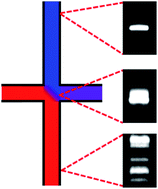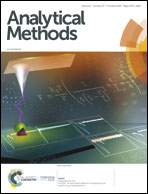Incorporation of thermal gels for facile microfluidic transient isotachophoresis†
Abstract
Transient isotachophoresis (tITP) is a robust analytical technique that integrates sample preconcentration with electrophoretic separation. Despite the benefits afforded by tITP, its implementation poses a significant technical challenge because discontinuous electrolytes must remain spatially segregated for analysis. Here, we present a unique strategy to simplify tITP execution by using thermally reversible gels. Gels with distinct electrolyte compositions were introduced into separate microchannels in a cross-channel PDMS device while in their liquid states. Temperature was then altered to solidify the gels, which limited electrolyte diffusion and enabled reliable tITP analyses of both small molecule dyes and DNA. System performance was characterized using model fluorescent dyes. Separation efficiencies of >106 plates m−1 were achieved with detection limits of 5 pM. This strategy was then expanded to the analysis of DNA where distinct stacking and sieving gels were incorporated into the device for analyte preconcentration and separation. This proof-of-concept experiment demonstrated that a DNA ladder could be focused and separated in <1 min. These results illustrate the suitability of thermal gel tITP for rapid analyses of biological macromolecules. This user-friendly tITP system provides low detection limits and high efficiency separations for diverse analytes using low-complexity, inexpensive microfluidic devices.

- This article is part of the themed collection: Analytical Methods Emerging Investigators


 Please wait while we load your content...
Please wait while we load your content...